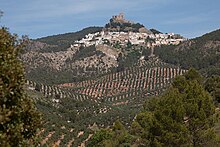Sierras de Cazorla, Segura y Las Villas
Sierras de Cazorla, Segura y Las Villas is a nature park in the northeast of the province of Jaén , with 214,300 hectares the largest in Andalusia .
Mountain ranges
The Sierra de Cazorla comprises the southwestern area of the nature park with the Gilillo (1847 m) as the highest peak. It takes its name from the town of Cazorla (just outside the nature park) . The Sierras de Las Villas are located north of the Sierra de Cazorla , in the northwest of the nature park. They are the lowest area. The highest mountain is El Blanquillo with around 1800 m. The east of the natural park is formed by the Sierra de Segura . This area is least discovered by tourism, but the highest peak, the Banderillas (1993 m), attracts hikers. In the south is the Sierra del Pozo , which does not appear in the name of the nature park , whose highest peak ( Cabañas ) at 2028 m is also an excellent vantage point.
Rivers
The Guadalquivir, which flows into the Atlantic, rises in this mountainous region belonging to the Betic Cordillera . It flows through a wide valley and is dammed in the Embalse del Tranco . Its tributaries, such as B. the only 11 km long Río Borosa , on the other hand, have often cut narrow and deep gorges into the mountains, which enormously increase the scenic beauty of the mountain landscape. The largest river flowing to the east and ultimately flowing into the Mediterranean is the Río Segura .
places
Four of the most beautiful places in the province of Jaén are in the area of the nature park or on its edge: Segura de la Sierra (approx. 1100 m), Hornos (approx. 860 m), La Iruela (approx. 900 m) and Cazorla (approx. 800 m) m) - all four are recognized as conjunto histórico-artístico .
economy
Field management is only possible in a few places in the mountainous and stony areas of the nature park; Livestock and forestry are much more important in economic terms. As everywhere in the province of Jaén, there are olive plantations here; Overall, however, they are less characteristic of the landscape than in other areas of the province. Tourism has been playing an increasingly important role since the 1960s - in summer the nature park is a popular travel destination for the Spaniards due to its altitude, cool forests and dams; in autumn it attracts hunters from all over the world.
fauna and Flora
The nature park is famous for its extensive forests, which already supplied the wood for the Spanish fleet, the Armada . The forests consist mainly of black pines , but there are also holm oaks - and Portuguese oak forests . In some cool places you can even find maples and holly trees . Hunters appreciate the abundance of game: European mouflons , Iberian ibex , red and fallow deer as well as wild boars are found in large numbers. The bird of prey world is also very rich in species such as the golden eagle , the Bonelli's eagle , the griffon vulture and the re-introduced bearded vulture . Iberian lynxes and wolves became extinct at the end of the 20th century.
See also
In the southeast, ie in the province of Granada , borders the Sierra de Castril Natural Park .
Web links
- Sierra de Cazorla Information on hikes, landscape and climate, fauna and flora and practical travel tips (arrival, starting points, accommodation, food and drink)
- Sierras de Cazorla, Segura y Las Villas Official website of the Natural Park Administration (Spanish speaking)
- Sierras de Cazorla, Segura y las Villas (Spanish speaking)
- German-language website for the Sierras de Cazorla, Segura y Las Villas nature park



